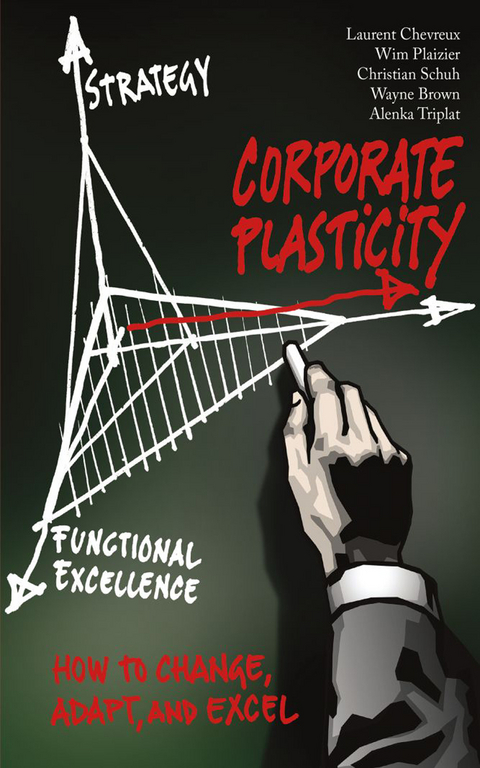
Corporate Plasticity
Apress (Verlag)
978-1-4302-6749-2 (ISBN)
In most organizations, strategy and functional excellence get the most attention. But even the best of either provides only limited long-term advantage. Highly effective organizations add Plasticity as a third dimension and rack up stellar breakthroughs—again and again. It is the key ingredient that allows strategy and functional excellence to deliver value.
As the authors show in Corporate Plasticity: How to Change, Adapt, and Excel, Plasticity also enables great organizations to break down barriers and collaborate in the pursuit of a common objective, and to reconfigure or rewire themselves to face down challenges or reach ever-stronger competitive positions.
Through entertaining stories and astute analysis, this book demonstrates that Plasticity spurs sports teams to become champions, companies to book record earnings, and artists to attain worldwide fame. You can use its principles—adaptability, flexibility, fluid networks and roles, lofty goals, and innovation, among others—to achieve operational excellence, tear down silos, and create more vibrant, creative enterprises. Your organization can become not just highly profitable and fun to work for, but an organization that can change the world.
Plasticity allows an organization to choose its own destiny, become versatile, and dare more than others. Its success lies in a set of abilities called the Magic 7:
Purpose: Your company must discover, select, and express what it is meant for.
Focus: Your company must have the courage to ignore everything that is not in line with its purpose, and then see that purpose through.
Culture: Your companymust create the conditions that allow people to work across boundaries and outside of predefined roles.
Spirit: Your company must inspire people to feel part of a cause that is bigger than they are.
Networking: Your company must provide the means, freedom, and encouragement for people to nurture and grow their internal and external networks continuously.
Knowledge: Your company must encourage experts to provide their knowledge and make it readily available to everyone who needs it.
Leadership: Your company's leaders must model and personify the characteristics they want others to adopt.
Silo thinking? Poor collaboration? Weak earnings? Strategies that gain no traction? Corporate Plasticity: How to Change, Adapt, and Excel is the answer. It shows you how to cultivate each of the seven disciplines to infuse Plasticity in an organization. That—along with razor-sharp strategy and crisp execution—will unleash the power you need to reach both personal and corporate goals. You might even change the world.
Christian Schuh is the leader of A.T. Kearney's Supply Management Practice in EMEA and is based in Vienna, Austria. He joined A.T. Kearney 17 years ago and has since then led multiple projects for clients in the automotive, construction equipment, defense, high tech, packaging, and steel industry in Austria, China, France, Germany, Russia, the UK, Ukraine, and the USA. His areas of expertise include strategic sourcing, high-end R&D, and organization. He is the author of various books (most notably The Purchasing Chessboard), monographs, and articles. Before he joined A.T. Kearney, he worked several years for Unilever. Schuh studied aeronautical engineering at TU Graz (Austria) and holds a doctorate in business administration. He lives in the historic city center of Vienna.
* The Beatles: It's all about the team * The Miracle on Ice: Adapt and win * Focus: Dutch yachtsman Conny an Rietschoten on eliminating all but the essentials Albert Einstein: Seeing the big picture * Apollo 13: NASA's mission control approach saves the day * D-Day: Coordination and courage * Baldwin Steam Locomotives: The consequences of myopic thinking * Teleonomy: How purpose is built into life itself * Giuseppe Arcimboldo: Making a harmonious whole out of disparate parts * The Golden Ratio and Fibonacci Series: Rhythms at the root of human activities * Communication of Ants: Nodal communication and optimization algorithms * Public spaces: Nourish networking and collaboration * Human Brain: Neuroplasticity and modular construction * The Roman Military: Why the maniple superseded the phalanx * Rugby: Blind passes to waiting receivers scores trys * Wikipedia: Why the breakthrough Encarta died at age 16 * Billy Beane's Oakland Athletics: Buying wins instead of players * Channel Tunnel: 15 organizations become one to succeed * NATO Forces: Beating back bureaucracy * Kodak: Voices for change ignored * Singapore's Changi Airport: Pride and culture makes it the best * The European Union: Poor strategy, little functional excellence, and no plasticity * Kent Redford: Melding conservation and synthetic biology * Apple Computer: The power of purpose * Google: The power of culture * Volkswagen: The power of spirit * Wartsila: The power of leadership * The Human Brain Project: The power of networking * Star Trek: The power of knowledge * Guns, germs and steel: The power of focus * Wolves: The power of organization * The Symphony Orchestra Conductor: How to lead * Director and Actor: Discovering people who can contribute * Humans: Plastic to their core
| Zusatzinfo | 8 Illustrations, black and white; X, 168 p. 8 illus. |
|---|---|
| Verlagsort | Berlin |
| Sprache | englisch |
| Maße | 178 x 254 mm |
| Themenwelt | Wirtschaft ► Betriebswirtschaft / Management ► Unternehmensführung / Management |
| Schlagworte | Plastizität • Unternehmensstrategie |
| ISBN-10 | 1-4302-6749-6 / 1430267496 |
| ISBN-13 | 978-1-4302-6749-2 / 9781430267492 |
| Zustand | Neuware |
| Haben Sie eine Frage zum Produkt? |
aus dem Bereich


